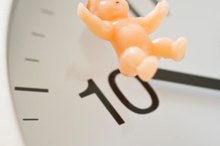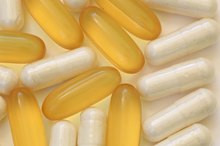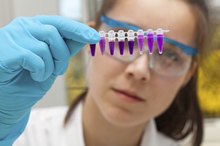Normal DHEA Sulfate Levels in Men
DHEA sulfate, formally known as dehydroepiandrosterone sulfate, is a male sex hormone produced in the adrenal glands of both men and women. Blood levels of the hormone are sometimes measured to gauge adrenal function and health. In men, normal levels of DHEA sulfate vary according to the age of the individual undergoing testing.
DHEA Sulfate Basics
DHEA sulfate belongs to a class of hormones called androgens, according to the American Association for Clinical Chemistry’s Lab Tests Online. During puberty, it helps bring about the development of male secondary sexual characteristics, such voice deepening and facial hair growth. Your body can also transform DHEA sulfate into stronger forms of androgens, such as androstenedione and testosterone. In women, the hormone can be transformed into estrogen. In addition to the adrenals, minor DHEA sulfate production takes places in the male testes and female ovaries.
- DHEA sulfate belongs to a class of hormones called androgens, according to the American Association for Clinical Chemistry’s Lab Tests Online.
- Your body can also transform DHEA sulfate into stronger forms of androgens, such as androstenedione and testosterone.
Normal Levels
How to Evaluate FSH Level Results
Learn More
If you are an 18- or 19-year-old male, your levels of DHEA sulfate will normally fall between 145 and 395 micrograms per deciliter of blood, according to the U.S. National Library of Medicine’s Medline Plus 1. Males between the ages of 20 and 29 have a normal range of 280 to 640 microgram/deciliter. Males between the ages of 30 and 39 have a normal DHEA sulfate range of 120 to 520 microgram/deciliter, while males between the ages of 40 and 49 have a normal range of 95 to 530 microgram/deciliter.
If you are a male between the ages of 50 and 59, normal DHEA sulfate levels fall between 70 and 310 microgram/deciliter. Men between the ages of 60 and 69 have a normal range of 42 to 290 microgram/deciliter, while men ages 69 and over have a normal range of 28 to 175 microgram/deciliter.
- If you are an 18- or 19-year-old male, your levels of DHEA sulfate will normally fall between 145 and 395 micrograms per deciliter of blood, according to the U.S. National Library of Medicine’s Medline Plus 1.
- Men between the ages of 60 and 69 have a normal range of 42 to 290 microgram/deciliter, while men ages 69 and over have a normal range of 28 to 175 microgram/deciliter.
Abnormal Results
If you have an elevated level of DHEA sulfate for your age and gender, you may potentially have a serious medical condition such as an adrenal gland tumor, adrenal cancer or adult-onset hyperplasia, Lab Tests Online reports. Low DHEA levels may indicate the presence of adrenal gland dysfunction or low output from your pituitary gland. In many cases, DHEA sulfate elevations do not produce any external signs of illness in men. However, your doctor may order a DHEA sulfate test if he suspects problems with your adrenal function 1. He may also use a DHEA sulfate test to distinguish between conditions linked to androgen secretion in your adrenal glands and conditions linked to secretion in your testes 1.
- If you have an elevated level of DHEA sulfate for your age and gender, you may potentially have a serious medical condition such as an adrenal gland tumor, adrenal cancer or adult-onset hyperplasia, Lab Tests Online reports.
DHEA Sulfate in Women
How to Determine Low or High FSH Levels
Learn More
As with men, DHEA sulfate levels in women vary with age, Medline Plus reports 1. In addition to causes found in men, a woman may experience DHEA sulfate elevations if she has polycystic ovary syndrome, or PCOS. Potential signs of elevation in women include acne, development of male physical characteristics and infertility.
Considerations
If you have abnormal DHEA sulfate levels, your doctor will typically perform further tests to detect any potential underlying causes, Lab Tests Online explains. If you take any type of DHEA supplement, you may have artificially elevated DHEA sulfate levels. Interpretation of DHEA sulfate test results may vary slightly depending on the laboratory doing the testing, Medline Plus notes 1.
Related Articles
References
- Medline Plus: DHEA -- Sulfate Test
- National Instutites of Health MedlinePlus. Wild yam. Updated April 18, 2018.
- National Institutes of Health MedlinePlus. DHEA. Updated May 29, 2019.
- Park SG, Hwang S, Kim JS, Park KC, Kwon Y, Kim KC. The association between dehydroepiandrosterone sulfate (DHEA-S) and bone mineral density in Korean men and women. J Bone Metab. 2017;24(1):31–36. doi:10.11005/jbm.2017.24.1.31
- von Mühlen D, Laughlin GA, Kritz-Silverstein D, Bergstrom J, Bettencourt R. Effect of dehydroepiandrosterone supplementation on bone mineral density, bone markers, and body composition in older adults: the DAWN trial. Osteoporos Int. 2008;19(5):699–707. doi:10.1007/s00198-007-0520-z
- Peixoto C, Devicari Cheda JN, Nardi AE, Veras AB, Cardoso A. The effects of dehydroepiandrosterone (DHEA) in the treatment of depression and depressive symptoms in other psychiatric and medical illnesses: A systematic review. Curr Drug Targets. 2014;15(9):901-14.
- Cleveland Clinic. Prasterone, DHEA tables or capsules (Dietary supplements).
- Archer DF. Dehydroepiandrosterone intra vaginal administration for the management of postmenopausal vulvovaginal atrophy. J Steroid Biochem Mol Biol. 2015 Jan;145:139-43. doi:10.1016/j.jsbmb.2014.09.003
- Freitas RP, Lemos TM, Spyrides MH, Sousa MB. Influence of cortisol and DHEA-S on pain and other symptoms in post menopausal women with fibromyalgia. J Back Musculoskelet Rehabil. 2012;25(4):245-52. doi:10.3233/BMR-2012-0331.
- Gómez-Santos C, Hernández-Morante JJ, Tébar FJ, et al. Differential effect of oral dehydroepiandrosterone-sulfate on metabolic syndrome features in pre- and postmenopausal obese women. Clin Endocrinol (Oxf). 2012;77(4):548-54. doi:10.1111/j.1365-2265.2011.04306.x.
- Panjari M, Davis SR. DHEA for postmenopausal women: a review of the evidence. Maturitas. 2010;66(2):172-9. doi:10.1016/j.maturitas.2009.12.017
Writer Bio
M. Gideon Hoyle is a writer living outside of Houston. Previously, he produced brochures and a wide variety of other materials for a nonprofit educational foundation. He now specializes in topics related to health, exercise and nutrition, publishing for various websites.









